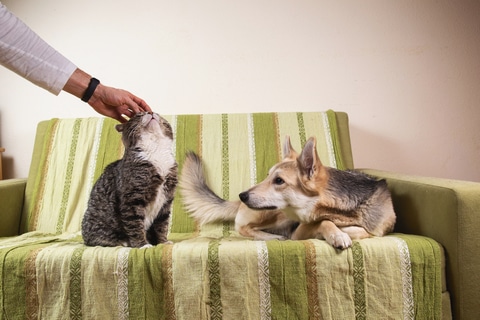Behavior, Everything, Dogs, Training
How to handle a jealous dog
You and your honey are spending some quiet time together. Your honey touches you, and your dog whines, growls, or tries to get between the two of you. Or perhaps a new baby has joined the family, and your dog has become withdrawn or aggressive.
Can dogs feel jealousy? Their behavior in some situations indicates that yes, they can. A change in behavior is understandable when they’re used to being the center of attention and they suddenly lose that attention and time to someone else.
The keys to preventing and overcoming jealousy in dogs are to make sure your dog doesn’t feel any loss of time or attention and to help him get to know the newcomer.
When your dog is jealous of a new adult
When a new person is spending time or living in your home, both you and the new person can help your dog adjust to the change.
Keep your dog’s routine. Jealousy comes in part from fear that the dog will lose his place in your life. Help alleviate that fear by keeping his life as normal as possible. Feed him at the same of day as usual, and if you have usual times to take him for walks and play with him, keep to that schedule too.
Give your dog extra attention. More attention is always welcome, and at a time when your dog is anxious, it helps reinforce his importance to you and makes him feel less threatened.
Have the new person spend time with the dog. If the new person takes the dog on some of his walks, plays with him, and feeds him some of the time, your dog will find it easier to recognize the new person as part of the family.
Reinforce basic training. Your dog may try to take control of the situation. If he behaves aggressively in the new person’s presence, use these times to reinforce basic training. Remind him that you are in charge, and he’ll be less likely to behave in unacceptable ways.
When your dog is jealous of a new baby
Before the baby arrives
If the new baby will be the first baby in your family, help your dog become accustomed to babies beforehand:
- Tape a baby crying, and play the tape at home several times a day.
- Bring your dog to the home of someone who has a baby, or invite that friend and her baby to your home. Let the dog see and smell the baby while you keep control of the dog.
- While you’re in the hospital, have your partner bring home a blanket or piece of clothing that the baby has used so that the dog can become familiar with the baby’s scent.
When you bring the baby home
You walk through the door, baby in arms, and your dog jumps up in his excitement to greet you after your absence. You admonish him.and he associates the baby with a negative experience.
A better way to handle the introduction is for you to come in the home first without the baby while your partner waits with the baby for a few minutes in the car. This way, your dog can enjoy his time with you first.
After he’s greeted you, he’ll be ready to find out about the newcomer. Allow him to see and smell the baby, and give him attention in the presence of the baby to reassure him that he’s still important too.
Baby space and dog space
Should your dog be allowed in the baby’s room? Some people say no, especially after the baby can crawl. Before then, however, keeping your dog out of the baby’s room means that he’s shut out of a lot of the family activity. Depending on your dog, you may want to just teach him that certain areas are out of bounds, such as the crib and the chair where you sit to nurse the baby.
After the baby can crawl, the baby and the dog should each have an area where the other one doesn’t intrude. A dog crate may be enough space for the dog to retreat to when he doesn’t want to be around the baby.
Both babies and dogs like toys that squeak. Keep their toys separate, and to reduce confusion, avoid giving them the same types of toys.
Baby and dog together and apart
Never leave your baby and dog alone together. They may appear to get along, but the baby’s uneven movements may trigger the dog’s hunting instinct. If your baby pulls on the dog’s ear or picks up his toys or food, your dog may react angrily. Let them get to know each other, but always supervise their time together.
Watch your dog’s body language. If you see any indication of annoyance or aggression, it’s time to separate your baby and your dog.
When your baby and your dog are together — and when they aren’t — be sure to give your dog lots of attention. Reinforce the idea that he’s still as loved and wanted as he was before the baby came. If you don’t have as much time to spend with your dog, ask your partner to spend more time with him. In particular, make sure that your dog continues to get regular exercise to burn off any excess energy.
Related articles
See also these articles at the OdorDestroyer.com site:


